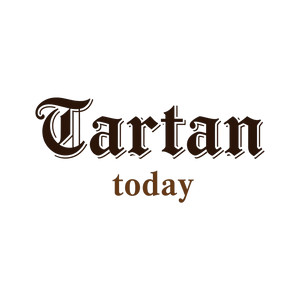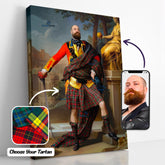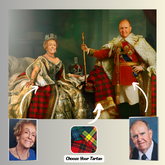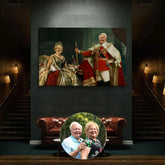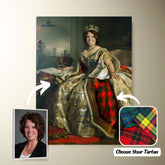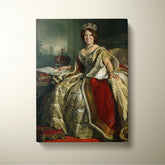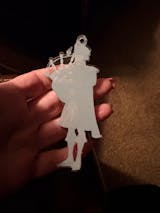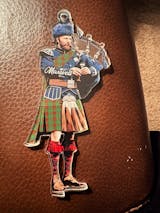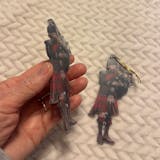-
Personalized Clan Blair Modern Tartan Bagpipe Ornament with Custom Name – Scottish Christmas Tree Decoration DO27
Personalized Clan Blair Modern Tartan Bagpipe Ornament with Custom Name – Scottish Christmas Tree Decoration DO27Celebrate your Scottish heritage with this unique wood & acrylic tartan ornament. Perfect as a personalized Christmas decoration or a meaningful gift for friends and relatives on special occasions...- From $19.99 USD
$25.99 USD- From $19.99 USD
- Unit price
- per
Save $6.00 -
Personalized Clan Blair Modern Tartan Drummer Ornament with Custom Name – Scottish Christmas Tree Decoration FW70
Personalized Clan Blair Modern Tartan Drummer Ornament with Custom Name – Scottish Christmas Tree Decoration FW70Celebrate your Scottish heritage with this unique wood & acrylic tartan ornament. Perfect as a personalized Christmas decoration or a meaningful gift for friends and relatives on special occasions...- From $19.99 USD
$25.99 USD- From $19.99 USD
- Unit price
- per
Save $6.00 -
Clan Blair Tartan Polo Shirt YG57 - Blair Tartan
Clan Blair Tartan Polo Shirt YG57 Description: Crafted in 100% polyester with your own design which combines comfort and vogue. This shirt has some'great features, it has 3 buttons, elastic collar and cuffs. 12.35 Oz. Made from polyester fabric. 3 buttons, elastic collar and...- $38.25 USD
- $38.25 USD
- Unit price
- per
-
Blair Tartan
-
Clan Blair Modern Tartan Crest Star Ceramic Ornament WO14 - Blair Modern Tartan
Clan Blair Modern Tartan Crest Star Ceramic Ornament WO14 One of the best things about Christmas is that it gives you an excuse to dress up your home with all of the lovely ornaments we associate with the holiday season. With so many different...- From $19.25 USD
- From $19.25 USD
- Unit price
- per
-
Blair Modern Tartan
-
Clan Blair Dress Tartan Crest Garden Flag - Welcome TI60 - Blair Dress Tartan Clan
Blair Dress Tartan Clan Crest Garden Flag - Welcome TI60 Product Detail: Welcome guests to your home with this seasonal flag. Available in 2 sizes: Small size 12'x18' and Large size 28'x40' Material: 100% polyester, PU and carbon black. Weatherproof and fade resistant fabric...- $35.45 USD
- $35.45 USD
- Unit price
- per
-
Blair Dress Tartan Clan
-
Personalized Clan Murray Blair sample Reproduction Tartan Bagpipe Ornament with Custom Name – Scottish Christmas Tree Decoration CT77
Personalized Clan Murray Blair sample Reproduction Tartan Bagpipe Ornament with Custom Name – Scottish Christmas Tree Decoration CT77Celebrate your Scottish heritage with this unique wood & acrylic tartan ornament. Perfect as a personalized Christmas decoration or a meaningful gift for friends and relatives on...- From $19.99 USD
$25.99 USD- From $19.99 USD
- Unit price
- per
Save $6.00 -
Personalized Clan Murray Blair sample Modern Tartan Bagpipe Ornament with Custom Name – Scottish Christmas Tree Decoration AE63
Personalized Clan Murray Blair sample Modern Tartan Bagpipe Ornament with Custom Name – Scottish Christmas Tree Decoration AE63Celebrate your Scottish heritage with this unique wood & acrylic tartan ornament. Perfect as a personalized Christmas decoration or a meaningful gift for friends and relatives on...- From $19.99 USD
$25.99 USD- From $19.99 USD
- Unit price
- per
Save $6.00 -
Personalized Clan Murray Blair sample Ancient Tartan Bagpipe Ornament with Custom Name – Scottish Christmas Tree Decoration ED41
Personalized Clan Murray Blair sample Ancient Tartan Bagpipe Ornament with Custom Name – Scottish Christmas Tree Decoration ED41Celebrate your Scottish heritage with this unique wood & acrylic tartan ornament. Perfect as a personalized Christmas decoration or a meaningful gift for friends and relatives on...- From $19.99 USD
$25.99 USD- From $19.99 USD
- Unit price
- per
Save $6.00 -
Personalized Clan Blairlogie Original Reproduction Tartan Bagpipe Ornament with Custom Name – Scottish Christmas Tree Decoration JI21
Personalized Clan Blairlogie Original Reproduction Tartan Bagpipe Ornament with Custom Name – Scottish Christmas Tree Decoration JI21Celebrate your Scottish heritage with this unique wood & acrylic tartan ornament. Perfect as a personalized Christmas decoration or a meaningful gift for friends and relatives on special...- From $19.99 USD
$25.99 USD- From $19.99 USD
- Unit price
- per
Save $6.00 -
Personalized Clan Blairlogie Original Modern Tartan Bagpipe Ornament with Custom Name – Scottish Christmas Tree Decoration AN81
Personalized Clan Blairlogie Original Modern Tartan Bagpipe Ornament with Custom Name – Scottish Christmas Tree Decoration AN81Celebrate your Scottish heritage with this unique wood & acrylic tartan ornament. Perfect as a personalized Christmas decoration or a meaningful gift for friends and relatives on special...- From $19.99 USD
$25.99 USD- From $19.99 USD
- Unit price
- per
Save $6.00 -
Personalized Clan Blairlogie Original Ancient Tartan Bagpipe Ornament with Custom Name – Scottish Christmas Tree Decoration VH85
Personalized Clan Blairlogie Original Ancient Tartan Bagpipe Ornament with Custom Name – Scottish Christmas Tree Decoration VH85Celebrate your Scottish heritage with this unique wood & acrylic tartan ornament. Perfect as a personalized Christmas decoration or a meaningful gift for friends and relatives on special...- From $19.99 USD
$25.99 USD- From $19.99 USD
- Unit price
- per
Save $6.00 -
Personalized Clan Blairlogie District Reproduction Tartan Bagpipe Ornament with Custom Name – Scottish Christmas Tree Decoration WL22
Personalized Clan Blairlogie District Reproduction Tartan Bagpipe Ornament with Custom Name – Scottish Christmas Tree Decoration WL22Celebrate your Scottish heritage with this unique wood & acrylic tartan ornament. Perfect as a personalized Christmas decoration or a meaningful gift for friends and relatives on special...- From $19.99 USD
$25.99 USD- From $19.99 USD
- Unit price
- per
Save $6.00 -
Personalized Clan Blairlogie District Modern Tartan Bagpipe Ornament with Custom Name – Scottish Christmas Tree Decoration YB76
Personalized Clan Blairlogie District Modern Tartan Bagpipe Ornament with Custom Name – Scottish Christmas Tree Decoration YB76Celebrate your Scottish heritage with this unique wood & acrylic tartan ornament. Perfect as a personalized Christmas decoration or a meaningful gift for friends and relatives on special...- From $19.99 USD
$25.99 USD- From $19.99 USD
- Unit price
- per
Save $6.00 -
Personalized Clan Blairlogie District Ancient Tartan Bagpipe Ornament with Custom Name – Scottish Christmas Tree Decoration JX33
Personalized Clan Blairlogie District Ancient Tartan Bagpipe Ornament with Custom Name – Scottish Christmas Tree Decoration JX33Celebrate your Scottish heritage with this unique wood & acrylic tartan ornament. Perfect as a personalized Christmas decoration or a meaningful gift for friends and relatives on special...- From $19.99 USD
$25.99 USD- From $19.99 USD
- Unit price
- per
Save $6.00 -
Personalized Clan Blairgowrie Reproduction Tartan Bagpipe Ornament with Custom Name – Scottish Christmas Tree Decoration QQ94
Personalized Clan Blairgowrie Reproduction Tartan Bagpipe Ornament with Custom Name – Scottish Christmas Tree Decoration QQ94Celebrate your Scottish heritage with this unique wood & acrylic tartan ornament. Perfect as a personalized Christmas decoration or a meaningful gift for friends and relatives on special occasions...- From $19.99 USD
$25.99 USD- From $19.99 USD
- Unit price
- per
Save $6.00 -
Personalized Clan Blairgowrie Modern Tartan Bagpipe Ornament with Custom Name – Scottish Christmas Tree Decoration ZZ65
Personalized Clan Blairgowrie Modern Tartan Bagpipe Ornament with Custom Name – Scottish Christmas Tree Decoration ZZ65Celebrate your Scottish heritage with this unique wood & acrylic tartan ornament. Perfect as a personalized Christmas decoration or a meaningful gift for friends and relatives on special occasions...- From $19.99 USD
$25.99 USD- From $19.99 USD
- Unit price
- per
Save $6.00 -
Personalized Clan Blairgowrie High School SA Reproduction Tartan Bagpipe Ornament with Custom Name – Scottish Christmas Tree Decoration CD12
Personalized Clan Blairgowrie High School SA Reproduction Tartan Bagpipe Ornament with Custom Name – Scottish Christmas Tree Decoration CD12Celebrate your Scottish heritage with this unique wood & acrylic tartan ornament. Perfect as a personalized Christmas decoration or a meaningful gift for friends and relatives...- From $19.99 USD
$25.99 USD- From $19.99 USD
- Unit price
- per
Save $6.00 -
Personalized Clan Blairgowrie High School SA Modern Tartan Bagpipe Ornament with Custom Name – Scottish Christmas Tree Decoration XL95
Personalized Clan Blairgowrie High School SA Modern Tartan Bagpipe Ornament with Custom Name – Scottish Christmas Tree Decoration XL95Celebrate your Scottish heritage with this unique wood & acrylic tartan ornament. Perfect as a personalized Christmas decoration or a meaningful gift for friends and relatives...- From $19.99 USD
$25.99 USD- From $19.99 USD
- Unit price
- per
Save $6.00 -
Personalized Clan Blairgowrie High School SA Ancient Tartan Bagpipe Ornament with Custom Name – Scottish Christmas Tree Decoration KC16
Personalized Clan Blairgowrie High School SA Ancient Tartan Bagpipe Ornament with Custom Name – Scottish Christmas Tree Decoration KC16Celebrate your Scottish heritage with this unique wood & acrylic tartan ornament. Perfect as a personalized Christmas decoration or a meaningful gift for friends and relatives...- From $19.99 USD
$25.99 USD- From $19.99 USD
- Unit price
- per
Save $6.00 -
Personalized Clan Blairgowrie Ancient Tartan Bagpipe Ornament with Custom Name – Scottish Christmas Tree Decoration BW88
Personalized Clan Blairgowrie Ancient Tartan Bagpipe Ornament with Custom Name – Scottish Christmas Tree Decoration BW88Celebrate your Scottish heritage with this unique wood & acrylic tartan ornament. Perfect as a personalized Christmas decoration or a meaningful gift for friends and relatives on special occasions...- From $19.99 USD
$25.99 USD- From $19.99 USD
- Unit price
- per
Save $6.00
Ex: Your Tartan + Product
Popular Products
Turn Me Royal Personalized Portrait from Your Photo, Custom Tartan. Custom Canvas Wall Art as Gift for Men
- From $32.45 USD
- From $32.45 USD
- Unit price
- / per
Royalty Couple Personalized Portrait from Your Photo, Custom Tartan. Custom Canvas Wall Art
- From $47.45 USD
- From $47.45 USD
- Unit price
- / per
The Queen Personalized Portrait from Your Photo, Custom Tartan. Custom Canvas Wall Art as Gift for Women
- From $32.45 USD
- From $32.45 USD
- Unit price
- / per
Which Clan Are You From?
- Blair
- Blair Ancient
- Blair clanBlair tartanPillow Cover
- Blair Dress
- Blair Dress Ancient
- Blair Dress Modern
- Blair Dress Reproduction
- Blair Dress Tartan
- Blair Dress Weathered
- Blair Modern
- Blair Modern Gnome
- Blair Modern Tartan
- Blair Reproduction
- Blair Tartan
- Blair Weathered
- Blairgowrie Ancient
- Blairgowrie High School SA Ancient
- Blairgowrie High School SA Modern
- Blairgowrie High School SA Reproduction
- Blairgowrie Modern
- Blairgowrie Reproduction
- Blairlogie District Ancient
- Blairlogie District Modern
- Blairlogie District Reproduction
- Blairlogie Original Ancient
- Blairlogie Original Modern
- Blairlogie Original Reproduction
- Murray Blair sample Ancient
- Murray Blair sample Modern
- Murray Blair sample Reproduction
- Scott
List Of Tartan
-
Clan A
- Abercrombie Tartan
- Aberdeen Tartan
- Abernethy Tartan
- Adair Tartan
- Adam Tartan
- Ayrshire Tartan
- Agnew Tartan
- Aikenhead Tartan
- Ainslie Tartan
- Aiton Tartan
- Allan Tartan
- Alexander Tartan
- Allardice Tartan
- Allison Tartan
- Anderson Tartan
- Angus Tartan
- Anstruther Tartan
- Arbuthnot Tartan
- Armstrong Tartan
- Arnott Tartan
- Auchinleck Tartan
- Ayrshire Tartan
-
Clan B
- Baillie Tartan
- Bain Tartan
- Baird Tartan
- Balfour Tartan
- Bannatyne Tartan
- Bannerman Tartan
- Barclay Tartan
- Baxter Tartan
- Beaton Tartan
- Bell Tartan
- Belshes Tartan
- Bethune Tartan
- Beveridge Tartan
- Binning Tartan
- Bisset Tartan
- Blackadder Tartan
- Blackstock Tartan
- Black Watch Tartan
- Blair Tartan
- Blane Tartan
- Blyth Tartan
- Borthwick Tartan
- Boswell Tartan
- Bowie Tartan
- Boyd Tartan
- Boyle Tartan
- Brisbane Tartan
- Brodie Tartan
- Brown/ Broun Tartan
- Bruce Tartan
- Buccleuch Tartan
- Buchan Tartan
- Buchanan Tartan
- Burnett Tartan
- Burns Tartan
- Butter Tartan
- Byres Tartan
-
Clan C
- Cairns Tartan
- Calder Tartan
- Callander Tartan
- Cameron Tartan
- Campbell Tartan
- Campbell of Breadalbane Tartan
- Campbell of Cawdor Tartan
- Carmichael Tartan
- Carnegie Tartan
- Carruthers Tartan
- Cathcart Tartan
- Chalmers Tartan
- Charteris Tartan
- Chattan Tartan
- Cheyne Tartan
- Chisholm Tartan
- Christie Tartan
- Clark Tartan
- Clelland Tartan
- Clephan Tartan
- Clergy Tartan
- Cochrane Tartan
- Cockburn Tartan
- Colquhoun Tartan
- Colville Tartan
- Cooper Tartan
- Couper Tartan
- Craig Tartan
- Cranstoun Tartan
- Crawford Tartan
- Crichton Tartan
- Crief District Tartan
- Crosbie Tartan
- Cumming Tartan
- Cunningham Tartan
- Currie Tartan
- Clan D
- Clan E
- Clan F
- Clan G
- Clan H
- Clan I
- Clan J
- Clan K
- Clan L
-
Clan M
- Maitland Tartan
- Malcolm Tartan
- Mar Tartan
- Marjoribanks Tartan
- Maxtone Tartan
- Matheson Tartan
- Maule Tartan
- Maxwell Tartan
- Meldrum Tartan
- Melville Tartan
- Menzies Tartan
- Mercer Tartan
- Middleton Tartan
- Moffat Tartan
- Moncrieffe Tartan
- Montgomery Tartan
- Monypenny Tartan
- Moncreiffe Tartan
- Monteith Tartan
- Morrison Tartan
- Mouat Tartan
- Moubray Tartan
- Mow Tartan
- Muir_More Tartan
- Muirhead Tartan
- Munro Tartan
- Murray Tartan
- Murray of Atholl Tartan
-
Clan Mc/Mac
- MacAlister Tartan
- MacArthur Tartan
- MacAlpine Tartan
- MacAulay Tartan
- MacBain Tartan
- MacBean Tartan
- MacBeth Tartan
- MacCallum Tartan
- MacCraig Tartan
- MacColl Tartan
- MacCorquodale Tartan
- MacDiarmid Tartan
- MacDonald Tartan
- MacDonald of Clanranald Tartan
- MacDonald of Sleat Tartan
- MacDonnell of Glengarry Tartan
- MacDonnell of Keppoch Tartan
- MacDougall Tartan
- MacDowall Tartan
- MacDuff Tartan
- MacEwen_MacEwan Tartan
- MacEdward Tartan
- MacFarlane Tartan
- MacGill Tartan
- MacGillivray Tartan
- MacGregor Tartan
- MacGowan (McGowan) Tartan
- MacHardy Tartan
- MacIan Tartan
- MacInnes Tartan
- MacIntyre Tartan
- MacKay Tartan
- MacKillop Tartan
- MacKellar Tartan
- Mackinlay Tartan
- MacKenzie Tartan
- Mackie Tartan
- MacKinnon Tartan
- MacKintosh / MacIntosh Tartan
- MacLeod Tartan
- MacMillan Tartan
- MacNab Tartan
- MacNaughton Tartan
- MacNeil / MacNeill Tartan
- MacNeil of Colonsay Tartan
- MacNicol Tartan
- MacPhail Tartan
- MacPhee_MacFie Tartan
- MacPherson Tartan
- MacQuarrie Tartan
- MacQueen Tartan
- MacRae Tartan
- MacRow Tartan
- MacSporran Tartan
- MacTaggart Tartan
- MacTavish Tartan
- MacThomas Tartan
- McCorquodale Tartan
- McCulloch Tartan
- McFadzen Tartan
- McGeachie Tartan
- McIver Tartan
- McKerrell Tartan
- Clan N
- Clan O
- Clan P
- Clan R
-
Clan S
- Sandilands Tartan
- Scott Tartan
- Scrymgeour Tartan
- Selkirk Tartan
- Sempill Tartan
- Seton Tartan
- Shaw Tartan
- Shepherd Tartan
- Sinclair Tartan
- Skene Tartan
- Skirving Tartan
- Smith Tartan
- Somerville Tartan
- Spalding Tartan
- Spens Tartan
- Spottiswood Tartan
- Stevenson Tartan
- Stewart Tartan
- Stewart of Appin Tartan
- Stirling Tartan
- Strachan Tartan
- Straiton Tartan
- Strange Tartan
- Strathclyde District Tartan
- Stuart of Bute Tartan
- Sutherland Tartan
- Swinton Tartan
- Clan T
- Clan U W Y
- Request Your Clan
Clan Blair (Blair Tartan)
1. About Clan Blair (Blair Tartan)
2. Clan Blair History (Blair Tartan)
The name Blair is derived from the Gaelic word "Blar," which means "open space or field" and is thus used in a variety of place names throughout Scotland.
Although the name was once more often written "Blare," this spelling has long since disappeared.
Despite the fact that many people have the surname Blair, it is generally recognized that the name alludes to two distinct clans: the Blairs of Blair from Ayrshire and the Blairs of Balthayock from Perthshire.
2.1 THE BLAIRS OF BLAIR
Timothy Pont makes reference to the records of the Kilwinning Monastery in 1608. These documents demonstrate that King William I of Scots (1165–1214), bestowed the title Barony of Blair upon Jean Francois (John Francis) of Normandy.
Along with the title, he would have received land, giving the family a significant amount of power. One of King John of England's daughters is believed to have been married to William de Blair, the grandson of John Francis de Blair.
A staunch ally of Sir William Wallace, his successor, Sir Bryce de Blair, was killed in the Barns of Ayr massacre in 1296.
After fighting beside him at Bannockburn in 1314, Sir Bryce's nephew Roger de Blair was given a knighthood by Robert the Bruce.
Following this, the clan rose to prominence in the area and had a number of successful marriages up until 1732, when William Blair of Blair's death brought an end to the clan's original line of succession.
Northern Ayrshire is home to Blair Castle, also known as Blair House, which served as the Blairs of Blair's ancestral home. By 1201, a stone Norman Keep with a moat and drawbridge had taken its place, which had originally been a wooden structure.
This Norman building is still there in Blair House today.
2.2 THE BLAIRS OF BALTHAYOCK
Stephen de Blair, who had property in the region that is now known as Blairgowrie, is the ancestor of the Blairs of Balthayock. He lived in the 12th century.
A witness to a charter of property at Balgillo (in Angus) named by an abbot of the abbey of Arbroath is the same Stephen de Blare/Blair.
Alexander de Blair, another Blair of Balthayock, who was most likely Stephens' son and who witnessed a charter in or around 1214.
He acquired the Cults holdings in Fife, which the Blairs had long owned, when he wed Ela, Hugh de Nyden's daughter. William de Blair, Alexander's son, was knighted by King Alexander II of Scotland and appointed Steward of Fife in 1235.
The book "The Blairs of Balthayock and Their Cadets" by Jack Blair, which is available from the Clan Blair Society, contains more information about the history of the Blairs of Balthayock.
For many years, the two families fought about who should hold the Chiefship. By declaring in 1658 that "The eldest male of either of the two Families would have precedence over the younger to the Chieftainship," King James VI finally put an end to the conflict.
Despite the fact that this assertion implies a connection between the two families, there are no records of marriages between Ayrshire and Perthshire, and given that the two families' coats of arms are distinct, it is most likely true that the two families have distinct ancestries.
3. Clan Blair Tartans
Modern family tartan that is straightforward but powerful is the Blair tartan. The Scottish Tartan Society measured the threadcount of a hand-colored tartan strip that had been in James Mackinlay's collection since the 1920s or 1930s.
'Modern' refers to the color's tint, which is typically darker.
G/12 R6 G48 K36 B48 R6 B/12 Threadcount
Blair Modern
4. Clan Blair Crest & Coats of Arms
4.1 Clan Blair Crest
Worn by all of the name and ancestry
4.2 Clan Blair Coats of Arms
Note on Coats of Arms: A coat of arms is given to an individual under Scottish heraldic law (with the exception of civic or corporate arms). A 'family coat of arms' does not exist.
With the exclusions listed above, the weapons depicted below are personal weapons. The only person authorized to use these weapons is the grantee.
Arms: Argent on a saltire between in the flanks two maunches, the sinister contournee, Sable five mascles Or.
Crest: a robin Or breasted Gules.
Motto: DIGNE FERO (I carry with dignity)
Supporters: Dexter a sea unicorn Argent armed crined and tail Sable finned Argent, and sinister a zebra Proper
Tags:
Clan-blair
5. Clan Blair Places & People
5.1 John Blair (c1300)
A Benedictine monk named John Blair served as Sir William Wallace's chaplain and comrade in arms while he was Scotland's governor. He also wrote on Wallace's life.
5.2 John Blair (died – 1782)
John was born and raised in Edinburgh, but he left Scotland when he was young to work as an usher at a school in London's Hedge Lane.
The Chronology and History of the World, from Creation to the Year of Christ 1753, was published by him in 1754. Reprints of it appeared in 1756, 1768, and 1814. Willoughby Rosse updated and expanded it for publication in Bohn's "Scientific Library" in 1856. He was chosen as a fellow of the Royal Society in 1755.
He served as the Princess Augusta of Saxe-Gotha's chaplain and the Prince Edward, Duke of York and Albany's math instructor in 1757. He was selected as a fellow of the Society of Antiquaries in 1761.
5.3 Robert Blair (1748–1828)
The University of Edinburgh appointed Robert Blair as its first Regius Professor of Astronomy in 1785. He also came up with the term for the aplanatic lens. This was an important development in the effort to lessen optical system aberration. He also conducted experiments using hollow glasses that contained various liquids.
- Choosing a selection results in a full page refresh.
